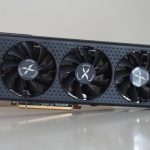When it comes to building a gaming PC, choosing the right graphics card is critical for achieving the desired gaming experience. AMD and Nvidia are the two leading brands in the GPU market, and gamers often compare models from both to find the best fit for their needs. In this article, we compare the AMD Radeon RX 6600 XT with its Nvidia equivalent, looking at performance, cost, power efficiency, and feature sets to help you determine which GPU is the right choice for your gaming rig.
RX 6600 XT vs. Nvidia Contender
Gaming Frame Rates and Resolution
When assessing GPUs, gaming performance is typically the top priority. The Radeon RX 6600 XT shines in 1080p gaming, providing high frame rates in most modern titles. To find its Nvidia equivalent, one should look at Nvidia’s offerings that deliver similar frame rates in the same resolution bracket. The Nvidia GeForce RTX 3060 stands as a close competitor, with both cards vying for dominance in the 1080p gaming space.
Graphical Fidelity and Ray Tracing
Graphical fidelity is another key factor, including the ability to handle features like ray tracing. This is where the Nvidia GPUs generally have an edge due to their dedicated RT cores. The RX 6600 XT offers ray tracing capabilities, but when compared with the RTX 3060, the latter may provide better performance in ray-traced games due to its hardware optimization for such tasks. Gamers keen on using ray tracing may find the Nvidia option more appealing.

Price-to-Performance Ratio
Comparing MSRPs and Street Prices
Price is a significant consideration when choosing a GPU. The MSRP (Manufacturer’s Suggested Retail Price) of the RX 6600 XT typically undercuts that of the RTX 3060, making it an attractive choice for budget-conscious builders. However, street prices can vary due to demand, availability, and market trends. It’s crucial to compare current prices and not just MSRPs to make an informed decision.
Long-Term Value and Resale Potential
Beyond the initial purchase price, prospective buyers should also consider the long-term value, including resale potential. Nvidia GPUs often hold their value longer, which could be an important consideration for those who frequently upgrade their PC components. The RTX 3060’s resale value may remain strong due to its brand recognition and demand.
Power Efficiency and System Requirements
Examining TDP and Power Consumption
The thermal design power (TDP) and overall power consumption are important specs for users with power supply constraints or those who prioritize energy efficiency. The RX 6600 XT has a lower TDP compared to the RTX 3060, which could mean lower electricity bills and less heat output. This makes the RX 6600 XT a potentially more power-efficient option.
System Compatibility and PSU Requirements
When integrating a new GPU into an existing system, compatibility with the power supply unit (PSU) is essential. The RX 6600 XT may be a better fit for systems with lower wattage PSUs due to its lower power requirements. Ensure that the PSU has the necessary connectors and wattage headroom for the GPU you choose.
Gaming Technologies and Software Ecosystems
Unique Technologies Offered by Each Brand
Both AMD and Nvidia offer unique features beyond raw performance. AMD’s FidelityFX Super Resolution (FSR) and Radeon Anti-Lag are appealing to gamers looking for enhanced image quality and responsiveness. On the other hand, Nvidia’s DLSS (Deep Learning Super Sampling) and G-Sync technology often sway users who want cutting-edge AI performance enhancements and smoother visuals.
Software Ecosystems and Driver Support
The software ecosystem and driver support can influence the overall user experience. Nvidia’s GeForce Experience software is a robust platform for driver updates, game optimization, and recording gameplay. AMD’s Radeon Software also provides a suite of features, including performance tuning and game streaming. Consider which software ecosystem aligns best with your preferences and needs.
In conclusion, comparing the AMD Radeon RX 6600 XT with an Nvidia equivalent like the RTX 3060 involves analyzing various aspects, including performance, price, power efficiency, and additional features. While the RX 6600 XT offers excellent 1080p performance and power efficiency at a competitive price, the RTX 3060 brings to the table superior ray tracing capabilities and a strong software ecosystem. Gamers should weigh these factors based on their individual needs, budget constraints, and expectations to find the GPU that provides the best gaming experience for them. Whether you prioritize raw performance, affordability, or power efficiency, both AMD and Nvidia have strong offerings that cater to the diverse demands of the gaming community.


